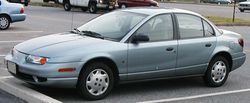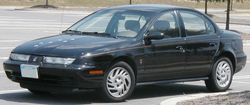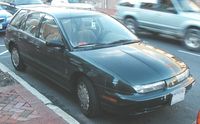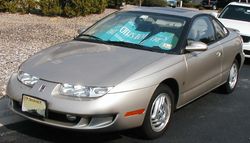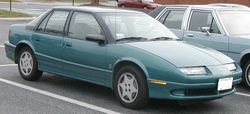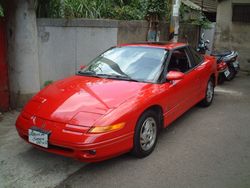.
Saturn S-Series: Difference between revisions
Red marquis (talk | contribs) mNo edit summary |
|||
| (One intermediate revision by one other user not shown) | |||
| Line 7: | Line 7: | ||
! colspan=2 style="text-align:center; font-weight:normal; background:#ddb;" | [[Saturn]] | ! colspan=2 style="text-align:center; font-weight:normal; background:#ddb;" | [[Saturn]] | ||
|- style="vertical-align:top;" | |- style="vertical-align:top;" | ||
| | | aka | ||
| | | | ||
|- style="vertical-align:top; background:#f0f0f0;" | |- style="vertical-align:top; background:#f0f0f0;" | ||
| Line 50: | Line 50: | ||
|} | |} | ||
The '''Saturn S-series'''' was sold between 1991-2002 and was replaced by the [[Saturn | The '''Saturn S-series'''' was sold between 1991-2002 and was replaced by the [[Saturn ION]]. The car featured [[Saturn]]'s traditional plastic door skins that were dent and rust proof, giving the car a very high resale value. Most customers were won over by Saturn's "No Haggle" pricing and helpful dealer networks. Unfortunately, the S-series was always playing catch-up to its Japanese competition. | ||
See Wikicars' comprehensive '''[[Saturn S-Series Review]]'''. | See Wikicars' comprehensive '''[[Saturn S-Series Review]]'''. | ||
| Line 783: | Line 783: | ||
'''SL/SW'''<br> | '''SL/SW'''<br> | ||
The first generation SL and SW are Saturn's first cars. The first S to leave the assembly line in the [[Spring Hill, Tennessee|Spring Hill]], Tennessee factory was on July 30, 1990. It was maroon with a tan interior. Originally there were two available trim levels. The '''SL1''' trim level featured a SOHC 1.9 Liter I4 LK0 engine that was rated at 85 [[horsepower]], which was upgraded to the 100 horsepower L24 engine for the 1995 model year. The '''SL2''' trim level featured a DOHC 1.9 Liter I4 LL0 engine that was rated at 124 horsepower. Both the SL1 and SL2 got 29MPG city, 35MPG Highway. The SL1 and SL2 had a 12 gallon fuel cell, which means that both cars got around 384 miles on a single tank (based on average of 32MPG.) After 1992, the sedan body style also came in a base SL trim level which was mechanically identical to the SL1 but with fewer available options. For model year 1993, the line expanded to include the SW1 and SW2 wagons, which were mechanically identical to their SL1 and SL2 counterparts. All models received an interior redesign for 1995. | The first generation SL and SW are Saturn's first cars. The first S to leave the assembly line in the [[Spring Hill, Tennessee|Spring Hill]], Tennessee factory was on July 30, 1990. That first Saturn leaved the same day Roger Bonham Smith retired. It was maroon with a tan interior. Originally there were two available trim levels. The '''SL1''' trim level featured a SOHC 1.9 Liter I4 LK0 engine that was rated at 85 [[horsepower]], which was upgraded to the 100 horsepower L24 engine for the 1995 model year. The '''SL2''' trim level featured a DOHC 1.9 Liter I4 LL0 engine that was rated at 124 horsepower. Both the SL1 and SL2 got 29MPG city, 35MPG Highway. The SL1 and SL2 had a 12 gallon fuel cell, which means that both cars got around 384 miles on a single tank (based on average of 32MPG.) After 1992, the sedan body style also came in a base SL trim level which was mechanically identical to the SL1 but with fewer available options. For model year 1993, the line expanded to include the SW1 and SW2 wagons, which were mechanically identical to their SL1 and SL2 counterparts. All models received an interior redesign for 1995. All S-series cars were offered with either a 5-speed manual transmission or a 4-speed automatic transmission. The Saturn transmissions in the DOHC vehicles were geared to enhance acceleration, while the SOHC transmissions were geared toward economy. There was also a special Homecoming edition of the SL2 which was released for [[1994]]. It had special Pearl White paint, black saturn emblems, spoiler, leather/cloth interior, rear headrests, sunroof and power locks and windows. 3,500 Homecoming models were produced. | ||
All S-series cars were offered with either a 5-speed manual transmission or a 4-speed automatic transmission. The Saturn transmissions in the DOHC vehicles were geared to enhance acceleration, while the SOHC transmissions were geared toward economy. | |||
There was also a special Homecoming edition of the SL2 which was released for [[1994]]. It had special Pearl White paint, black saturn emblems, spoiler, leather/cloth interior, rear headrests, sunroof and power locks and windows. | |||
'''SC/SC2'''<br> | '''SC/SC2'''<br> | ||
Latest revision as of 06:43, 21 December 2010
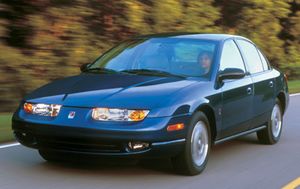
| |
| Saturn S-Series | |
|---|---|
| Saturn | |
| aka | |
| Production | 1991-2002 |
| Class | Compact |
| Body Style | 4-door Sedan 5-door Wagon 2-door coupe 3-door coupe |
| Length | 178.1 in |
| Width | 66.4 in |
| Height | 55.6 in |
| Wheelbase | 102.4 in |
| Weight | 2,461-2,489 lbs |
| Transmission | 5-speed manual 4-speed automatic |
| Engine | 1.9 liter inline-4 |
| Power | 124 hp @ 5600 RPM 122 lb-ft of torque at 4800 RPM |
| Similar | Toyota Corolla Honda Civic Nissan Sentra Dodge Neon Mazda Protege |
| Designer | |
The Saturn S-series' was sold between 1991-2002 and was replaced by the Saturn ION. The car featured Saturn's traditional plastic door skins that were dent and rust proof, giving the car a very high resale value. Most customers were won over by Saturn's "No Haggle" pricing and helpful dealer networks. Unfortunately, the S-series was always playing catch-up to its Japanese competition.
See Wikicars' comprehensive Saturn S-Series Review.
Recent Changes
This model was replaced by the Saturn Ion in 2002.
Year by Year Changes
1997- Unchanged.
1998- Mechanical components stiffened in an effort to reduce noise and increase durability. Wheel covers were restyled and the automatic transmission shift points were altered for smoothness.
1999- Drum brakes replace the discs used on previous models with ABS.
2000- Sedan and wagon models mildly redesigned. Models received new front and rear fascias, new instrument cluster and center console with cupholders. The horn now worked via the entire hub of the steering wheel, replacing the twin horn buttons of before. Cruise control was moved to the spokes. The front seats were given a greater length of travel, and child safety seat anchors were added to the rear seat.
2001- Side curtain airbags offered as an option. The base SL sedan was given these standard features: body-colored bumpers, right-side rearview mirror and power steering.
Styles and Major Options
The last generation S-series was offered in sedan, coupe and wagon bodystyles. The sedan was available in SL, SL1 and SL2 trims; the coupe in SC1 and SC2 trims; and the wagon only in the SW2 trim.
Pricing
Today's prices for the S-series are unavailable as the vehicle is out of production. The 2001 prices are listed below, and are available from New Car Test Drive.com
|
S-Series Trims |
||||||
|
Bodystyle |
Sedan |
Coupe |
Wagon |
|||
|
Trim |
SL |
SL1 |
SL2 |
SC1 |
SC2 |
SW2 |
|
MSRP |
||||||
|
$10,570 |
$11,485 |
$12,895 |
$12,535 |
$15,645 |
$14,290 |
|
|
Invoice |
||||||
|
$xx,xxx |
$xx,xxx |
$xx,xxx |
$xx,xxx |
$xx,xxx |
$xx,xxx |
|
Gas Mileage
As seen on the FuelEconomy.gov website, the City/Highway MPG averages are as follows:
|
Transmission |
|||
|
Manual |
Automatic |
||
|
MPG |
|||
|
27/38 |
25/36 |
||
Reliability
Warranty options and scheduled maintainence information should be mentioned here.
Safety
Standard Safety Features
- Driver and Front passenger airbags
The S-Series was tested by the NHTSA and the full results can be found at safercar.gov.
|
Rating (Stars) |
|||||
|
Front |
Side |
Rollover |
|||
|
Driver |
Passenger |
Front Seat |
Rear Seat |
2WD |
4WD |
|
5 |
5 |
3 |
2 |
4 |
- |
Photos
Colors
Exterior colors are listed based on interior appointments.
|
Trim |
Interior |
||||
|
Cloth |
Leather |
||||
|
Grey |
Tan |
Black |
Grey |
Tan |
|
|
SL |
Blue |
- |
- |
- |
- |
|
SL1 |
Black Silver |
Gold |
Black Silver |
- |
- |
|
SL2 |
Black Silver |
Gold |
Black Silver |
Black Silver |
Gold |
|
SW2 |
Cranberry |
Gold |
- |
Cranberry |
Gold |
|
SC1 |
Black |
- |
Black |
- |
- |
Main Competitors
Hybrid Models
No hybrid models of the S-Series were produced.
Unique Attributes
If there are any features of this vehicle that sets it apart from other vehicles in its class, then mention those unique attributes here.
Resale Values
Maximum suggested retail value for an Excellent condition base model according to Kelley Blue Book.
|
S-series Year |
|||||||||||
|
2001 |
2000 |
1999 |
1998 |
1997 |
1996 |
1995 |
1994 |
1993 |
1992 |
1991 |
|
|
Resale Value |
|||||||||||
|
SL |
$5,515 |
$4,805 |
$4,260 |
$3,575 |
$3,035 |
$2,685 |
$2,500 |
$2,350 |
$2,325 |
$2,100 |
$1,925 |
|
SL1 |
$6,090 |
$5,465 |
$4,860 |
$4,325 |
$3,725 |
$3,275 |
$2,975 |
$2,750 |
$2,625 |
$2,350 |
$2,150 |
|
SL2 |
$6,615 |
$5,915 |
$5,285 |
$4,700 |
$4,275 |
$3,750 |
$3,375 |
$3,100 |
$2,875 |
$2,660 |
$2,485 |
|
SC1 |
$6,720 |
$5,715 |
$5,085 |
$4,525 |
$4,100 |
$3,500 |
$3,100 |
$2,850 |
$2,675 |
- |
- |
|
SC2/SC |
$7,440 |
$6,250 |
$5,560 |
$4,900 |
$4,475 |
$4,100 |
$3,550 |
$3,225 |
$3,060 |
$2,735 |
$2,535 |
|
SW1 |
- |
- |
$5,135 |
$4,600 |
$4,175 |
$3,575 |
$3,225 |
$2,975 |
$2,800 |
- |
- |
|
SW2 |
$6,890 |
$6,190 |
$5,535 |
$4,950 |
$4,475 |
$4,125 |
$3,550 |
$3,275 |
$3,050 |
- |
- |
Criticisms
Please make sure to keep critiques in a third-person point of view. If using criticisms from a reputable automotive source, then please make sure to cite the quote.
Generations
Third generation (2000—2002)
SL/SW
The third generation SL/SW was produced from model year 2000 until 2002. The third generation shares the same space frame design as the second generation, but features a redesigned interior and exterior polymer panels, resulting in an addition of 1.2 in to overall length. Mechanically, the car stayed nearly identical to the second generation.
SC
The third generation SC was produced from model year 2001 until 2002. Like the third generation SL/SW, the third generation SC remains relatively the same aside from exterior body panels, and using the newer interior introduced in 2000.
Second generation (1996–1999)
SL/SW
The second generation SL and SW were made from model year 1996 to 1999. The redesign resulted in a more curved look for the SL/SW, which gave a slight increase in interior room and doorway size as well as an updated appearance. Mechanically, very little was changed from the previous model, though 1996 was the first year for the OBDII PCM.
SC
The second generation SC was made from model year 1997 to 2000. For the second generation, the bodies of the SC1 and SC2 became identical, with only subtle paint and feature differences between the models, the most distinguishing being the presence of fog lights on the SC2 models. The second generation SC also moved to the longer wheelbase of the SL/SW models, resulting in an equal wheelbase across all models. The redesign resulted in a more curved look for the SC, which gave a slight increase in interior room and doorway size as well as an updated appearance. Mechanically, very little was changed from the previous model. For the 1999 model year, a small suicide third door was added to the driver's side. This door provides easier access to and from the rear seat. The door's latch is on its front edge, and is thus inaccessible unless the front door is open; this prohibits a user from opening (or closing) the rear door if the front door is not open.[1] An interior redesign occurred in 2000.
First generation (1991–1995)
SL/SW
The first generation SL and SW are Saturn's first cars. The first S to leave the assembly line in the Spring Hill, Tennessee factory was on July 30, 1990. That first Saturn leaved the same day Roger Bonham Smith retired. It was maroon with a tan interior. Originally there were two available trim levels. The SL1 trim level featured a SOHC 1.9 Liter I4 LK0 engine that was rated at 85 horsepower, which was upgraded to the 100 horsepower L24 engine for the 1995 model year. The SL2 trim level featured a DOHC 1.9 Liter I4 LL0 engine that was rated at 124 horsepower. Both the SL1 and SL2 got 29MPG city, 35MPG Highway. The SL1 and SL2 had a 12 gallon fuel cell, which means that both cars got around 384 miles on a single tank (based on average of 32MPG.) After 1992, the sedan body style also came in a base SL trim level which was mechanically identical to the SL1 but with fewer available options. For model year 1993, the line expanded to include the SW1 and SW2 wagons, which were mechanically identical to their SL1 and SL2 counterparts. All models received an interior redesign for 1995. All S-series cars were offered with either a 5-speed manual transmission or a 4-speed automatic transmission. The Saturn transmissions in the DOHC vehicles were geared to enhance acceleration, while the SOHC transmissions were geared toward economy. There was also a special Homecoming edition of the SL2 which was released for 1994. It had special Pearl White paint, black saturn emblems, spoiler, leather/cloth interior, rear headrests, sunroof and power locks and windows. 3,500 Homecoming models were produced.
SC/SC2
The first generation SC was made from model year 1991 to 1996. Originally only one trim level, SC was available with a DOHC 1.9 Liter I4 LL0 engine that was rated at 124 horsepower. For 1993, the original SC trim level was renamed SC2, and an SC1 trim level was introduced. The first generation SC2 received a minor refresh for 1995. The lower front bumper, trunk lid reflector, and interior were redesigned.
SC1
Introduced for model year 1993, the SC1 was created as a base-level coupe. The SC1 featured a SOHC 1.9 Liter I4 LK0 engine that rated at 85 horsepower. The SC1 engine was later upgraded to the 100 horsepower L24 engine for the 1995 model year. The first generation SC1 was notably different from the up level SC2, with a completely different front fascia lacking the pop-up headlights, and a slightly different rear end lacking a trunk lid reflector.
Worldwide
If the vehicle is sold in other markets worldwide, then this is the section to mention that information. Also, mention if the <MODEL> goes by another name in these other markets.
Design quirks and oddities
Awards
- Won IntelliChoice "Best Overall Value" award for six straight years.
See also
| image (between 170-190 pixels) | ||
| SATURN | ||
|
Historic Astra · L-Series · ION · Relay · S-Series · Aura · Sky · VUE · Outlook Concept Sky Concept · Curve · Include notable internal links here | ||
| Roger Smith, former GM CEO | Corporate website | defunct |
This page uses content from Wikipedia; see Saturn S-Series, which includes these contributors.
